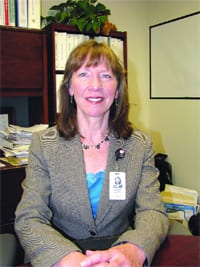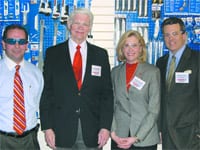Baystate Healthy System’s Program Incentivizes Employees to Do the Right Things
Barbara Pelletier says the industry term is “sleep hygiene.”
It is used by those who diagnose and treat sleep disorders, she said, to describe healthy sleeping habits. This means everything from choosing dark, quiet places for sleep, to not having caffeine-laden drinks before going down for the night, to knowing what to do, or not to do, when you wake up in the middle of the night (leave the light off, if you can).
Teaching sound sleep hygiene is just a small part of an ambitious program called Baystate Healthy, a term that describes both what this is and where it is taking place. The latter is the Baystate Health system, and the former is a comprehensive health and wellness program put in place in 2007.
Summarizing the effort, Pellitier, who came to the system from Aetna, where she coordinated health and wellness programs for 20 years, said it is designed to improve the overall health of Baystate’s 10,000 or so employees, driving down health care costs in the process and improving productivity.
Healthy sleep is just one of Baystate Healthy’s principal points of focus, said Pelletier, Baystate’s director of Health and Wellness. Others include physical activity and promoting more of it, weight and efforts to control it, stress and methods to reduce it, and a general topic she calls health knowledge. This refers to everything from knowing one’s cholsterol — the first step in controlling it — to understanding when it’s prudent to rush to one’s doctor or the emergency room, and when it isn’t.
There are several formal and informal goals behind the creation of Baystate Healthy, said Pelletier, noting that among that first category is reducing the percentage of employees in what is considered the ‘high-risk’ category for health problems and greatly increasing the number in the low-risk realm. Such low-risk individuals have no more than two of the 15 risk factors, which range from high blood pressure to alcohol use; from risk of depression to obesity.
At present, only 40{06cf2b9696b159f874511d23dbc893eb1ac83014175ed30550cfff22781411e5} of the hospital’s workforce is in that low-risk category, and the goal is to get 70{06cf2b9696b159f874511d23dbc893eb1ac83014175ed30550cfff22781411e5} and perhaps the 80{06cf2b9696b159f874511d23dbc893eb1ac83014175ed30550cfff22781411e5} boasted by Johnson & Johnson, which, says Pelletier, proclaims itself “the World’s Healthiest Company.”
Getting there won’t happen this year, or next, or the year after that, she continued, noting that it may be a decade or more before the hospital realizes the goals it set when it put the program in place. “This is a long-term proposition,” she explained, “and the system understood this when it launched Baystate Healthy. We’re in this for the long haul.”
Putting Baystate Healthy in place is one thing, said Pelletier, noting that the hospital invested several years and vast resources to blueprint the plan, while making it work is another, and that is essentially her job. She told The Healthcare News that the basic philosophy is to incentivize employees to take part with a rewards program (much more on that later) designed to trigger response from those who might otherwise be inclined to sit on the sidelines.
“It’s an important strategy we’re using to really motivate specific behaviors and engage our employees,” she explained. “And also to reach people who don’t typically tune in to what our messages are; it’s all voluntary, but this serves to promote action and hopefully sustain change.”
Meanwhile, Pelletier has been hard at work devising ways to make the various components of the initiative fun, another necessary ingredient for success.
As just one example, she pointed to the system’s Baystate Healthy Festivals, staged at various sites each fall. The events include a host of screenings — bone density, blood pressure, cholesterol, and diabetes risk, another others — but also demonstrations in belly dancing, hula-hooping, tai chi, and zumba, a fusion of Latin and international music that creates a dynamic, exciting, and effective fitness system.
“Fun has to be part of the equation,” said Pelletier. “It promotes participation … it makes people want to take part, and that’s an important element in our success.”
Steps in the Right Direction
The Baystate Healthy quarterly program and event guide looks and reads a little like a restaurant menu — and with good reason.
It’s designed to show the many categories of general health, wellness, and work/life solutions and list the choices people have if they decide to focus on such areas, said Pelletier.
Under the ‘fitness’ category, for example, employees can consider the employee fitness center, located just a few blocks from Baysytate Medical Center, exercise videos that are available for home use, group exercise classes, walking clubs (there are several of them), and that aforementioned zumba. Under ‘stress reduction,’ employees can find Baystate’s employee assistance program, chair massage offerings, stress-reduction DVDs, and something called the Mindfulness Based Stress Reduction Program.
There are more options under ‘Nutrition and Weight Management,’ ‘Caring for Others,’ ‘Smoking Cessation,’ and even ‘Financial Fitness,’ said Pelletier, adding that the breadth and depth of this menu of offerings covers the many health and wellness issues facing a large and in all ways diverse workforce.
And it is designed to meet the prime directive when it comes to such initiatives — to get people involved.
Overall, Baystate Healthy focuses on several key areas, said Pelletier, listing, again, physical activity, weight management (the nation has an obesity problem, and the Baystate population is no different), sleep hygiene, stress reduction, and what she calls simply “being informed.”
“We call it ‘knowing your numbers,’” she explained. “We find that a lot of people don’t even know their cholesterol numbers — and they need to know.”
All play a role in one’s general health and well-being, she explained, but they also affect job performance and overall productivity. Poor sleep habits, she noted, can affect one’s work in a number of ways, while stress can also take a real toll on performance. Meanwhile, these and other issues contribute to higher levels of sick time and greater workers’ compensation costs.
Companies across the country are coming to this realization, said Pelletier, adding that the health care sector in particular is addressing the matter with programs that, like Baystate’s, are designed to create a culture of health.
“There’s research being done showing that healthier people not only are sick less often so they can get to work, they have lower absenteeism, and they also have lower rates of workers’ comp,” she explained. “They also have improved scores in terms of presenteeism (when people come to work despite being sick, causing other problems), so when they’re at work they can function better, make fewer errors, and concentrate better. There’s a lot of good data now that’s creating some fuel for companies to look into these programs.”
To make Baystate Healthy succeed as designed, Pelletier says the system takes an approach based on the use of carrots, not sticks. “And there are no orange-colored sticks,” she said, “or the carrots that really are sticks.”
Elaborating, she said that, rather than force employees to participate and legislate that they do the right things — such as not smoke or get to, or close to, their designated body mass index (BMI) number — the system instead encourages participation and offers incentives for those who take part.
That initiative comes in the form of Baystate Healthy Rewards, which employees can earn in any number of ways. And if they earn 200 of them between Jan. 1 and Oct. 31 of this year, they will be eligible for a $200 wellness credit toward their health insurance premium or $200 to be placed in their savings account.
Points, 50 of them, can be earned simply by taking the 2009 Health Questionnaire (25 points are awarded for the quicker ‘snapshot’ version), said Pelletier, adding that there are rewards for participating in various health activities (such as regular use of the fitness center) and online programs.
And 25 points can be earned by attending a workshop and then following the words of advice in something called the Healthwise Handbook, described as “a self-care guide for you and your family. Its chapters offer good reading on topics ranging from first aid and emergiencies to common health problems; from “living better with chronic disease” to “better care, lower costs,” which informs readers about when they need to call the doctor and when they can treat something at home.
“In addition to the focus on physical activity, healthy sleep, weight control, and other issues, an important focus for us is on making good health care decisions,” she explained. “This is a major cornerstone of our program; we want to help people to be better health care consumers.
“And by that, we mean to recognize signs and symptoms, know when to use home treatments if and when it’s appropriate, know when to call your doctor when it’s appropriate, know when to expedite care, and know when to get to your doctor immediately,” she continued. “And, in general, to make better choices about health care for you and your family.”
Scoring Points
Pelletier says she doesn’t know how many employees will cross the 200-point plateau over the next few weeks or so. She expects that it will be a few thousand when all is said and done.
That’s a good number, but still a relatively small percentage of the total workforce. Still, this represents a very good rate of progression for a program that is in all ways a marathon and not a sprint. Achieving better rates of participation and lowering the number of employees in the high-risk category is like embarking on any health or wellness program, she said.
Progress doesn’t come overnight, but rather through continued focus on doing the right things, making the right decisions, and sticking with the program — or programs.
And some good sleep hygiene would probably help as well.





Comments are closed.